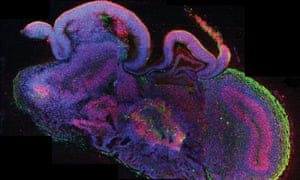Kim, J. H., Kim, M., et al. (2025).
Biosensors and Bioelectronics, 287, 117703.
Abstract
Neural organoids provide a promising platform for biologically inspired computing due to their complex neural architecture and energy-efficient signal processing. However, the scalability of conventional organoid cultures is limited, restricting synaptic connectivity and functional capacity—significant barriers to developing high-performance bioprocessors. Here, we present a scalable three-dimensional (3D) packaging strategy for neural organoid arrays inspired by semiconductor 3D stacking technology. This approach vertically assembles Matrigel-embedded neural organoids within a polydimethylsiloxane (PDMS)-based chamber using a removable acrylic alignment plate, creating a stable multilayer structure while preserving oxygen and nutrient diffusion. Structural analysis confirms robust inter-organoid connectivity, while electrophysiological recordings reveal significantly enhanced neural dynamics in 3D organoid arrays compared to both single organoids and two-dimensional arrays. Furthermore, prolonged culture duration promotes network maturation and increases functional complexity. This 3D stacking strategy provides a simple yet effective method for expanding the physical and functional capacity of organoid-based systems, offering a viable path toward next-generation biocomputing platforms.
What does this mean and why am I posting this?
What the Research Accomplishes
The study develops a novel 3D "packaging" technique for brain organoids - essentially lab-grown mini-brains derived from stem cells. The researchers stack these organoids vertically in layers, similar to how semiconductor chips are stacked in advanced computer processors. This creates what they call "high-capacity bioprocessors" - biological computing systems that can process information using living neural networks.
The key innovation is overcoming a major limitation of previous organoid-based computers: as brain organoids grow larger to gain more processing power, their cores die from lack of oxygen and nutrients. The researchers solved this by creating a columnar arrangement that allows better diffusion of oxygen and nutrients while maintaining neural connectivity between layers.
Technical Significance
The results are remarkable from a purely technical standpoint. The 3D-stacked organoid arrays showed significantly enhanced neural activity compared to single organoids or flat 2D arrangements. The vertical stacking promotes better inter-organoid connectivity, creating richer and more synchronized neural networks. This represents a genuine scaling solution for biological computing systems.
The researchers demonstrate that these bioprocessors can perform AI-related tasks like voice recognition and nonlinear equation prediction while being more energy-efficient than conventional silicon-based systems. This mirrors the brain's ability to process vast amounts of information while consuming remarkably little power.
Implications for Consciousness Research
This work is particularly intriguing for consciousness research for several reasons:
Emergent Complexity: The 3D stacking creates more complex neural architectures that better replicate the structural properties of actual brain tissue. As the paper notes, performance scales with the number of neurons and synapses - suggesting that sufficient complexity might lead to emergent properties we associate with consciousness.
Network Integration: The enhanced inter-organoid connectivity creates integrated information processing networks. Many theories of consciousness, particularly Integrated Information Theory, suggest that consciousness emerges from integrated information processing across neural networks.
Biological Authenticity: Unlike artificial neural networks, these systems use actual biological neurons with genuine synaptic plasticity and learning mechanisms. This biological authenticity might be crucial for generating subjective experience rather than just computational behavior.
Scalability: The technique provides a clear path toward creating much larger and more complex biological neural networks. If consciousness requires a certain threshold of complexity and integration, this approach could potentially reach that threshold.




